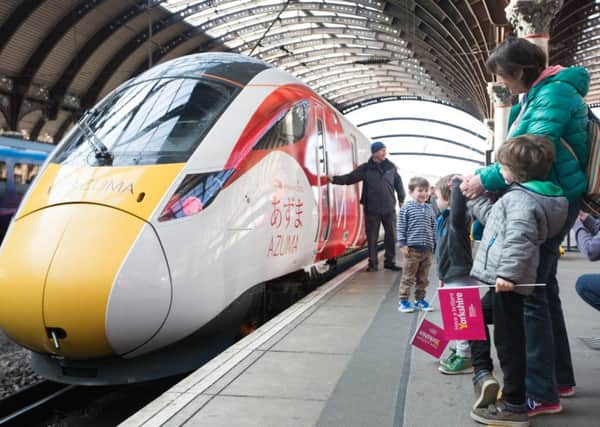Competition is rail's ticket to the future


You will recall the comically poor sandwiches and dirty trains alongside the doom-laden headlines of terminal decline, falling passenger numbers and soaring subsidies alongside some terrible safety failings.
This month marks the 25th anniversary of the policy which led to railway privatisation and did so much to reverse this decline and secure long-overdue investment in new trains and a safer railway.
Advertisement
Hide AdAdvertisement
Hide AdBut while a booming railway is a nice problem to have, there is still so much more to do to improve the passenger experience and deliver value for money. Conservatives now need to finish the job they started a quarter of a century ago.
John Major’s railway White Paper in the summer of 1992 pledged to deliver “more competition, greater efficiency and a wider choice of services more closely tailored to what customers want”.
It was right then and is right now but Conservatives have so far delivered an unsatisfactory halfway house where most passengers don’t enjoy this trumpeted choice and competition.
The political and sector opportunities of finally delivering on this are huge if Ministers look at the latest passenger satisfaction survey and consider the results.
Advertisement
Hide AdAdvertisement
Hide AdFirstly it is important to appreciate the revival of rail travel in the UK.
Passenger journeys on the network have more than doubled since privatisation, from 735 million in 1994 to 1.7 billion in 2016, and have almost trebled since the 1982 post-war slump.
But what of the White Paper’s key objectives a quarter of a century later?
Some passengers may roll their eyes when they read this based on their own experiences but last month’s National Rail Passenger Survey shows that many of these ambitions are now being delivered – on just one main line.
Advertisement
Hide AdAdvertisement
Hide AdAt London King’s Cross the main train franchise, Virgin Trains East Coast (VTEC), faces stiff competition from two non-franchised high-speed ‘open access’ train operators on inter-city services between London, Yorkshire and the North East.
These trains all compete on the East Coast Main Line (ECML) and record the highest passenger satisfaction ratings anywhere in the country. Hull Trains comes top with 97 per cent, followed by York based Grand Central on 94 per cent and VTEC with 91 per cent.
Grand Central and Hull Trains also came top on value for money, reliability, punctuality and getting a seat.
The message is clear; when passengers have real choice, and train companies face competition on the same track, then operators raise their game.
Advertisement
Hide AdAdvertisement
Hide AdIt is a clear and unarguable fact that they deliver better services at competitive fares because they have to fight for passengers.
This rivalry has also delivered innovations such as free wi-fi, special flexible ticket deals and new routes as operators look to serve extra towns and cities to boost their offering.
The open-access operators have connected places with London which lost their direct rail services years ago under British Rail as well as directly competing with the franchise on the same track at places like York, Bradford, Doncaster, Hull and London.
But why is such competition not network-wide? Why are Ministers afraid of encouraging and delivering this model across the railways?
Advertisement
Hide AdAdvertisement
Hide AdIn many respects, Yorkshire folk are lucky as this is not the case elsewhere in the UK.
At Paddington, the Great Western franchise enjoys a complete monopoly on services across vast swathes of western England and Wales and endures one of the lowest satisfaction scores.
Consequently, there is no competition on long-distance fares where only 48 per cent of passengers think tickets are value for money.
Similarly, at London Liverpool Street, where Greater Anglia services enjoy a ‘railopoly’ to serve eastern England, just 42 per cent of travellers agreed on value for money.
Advertisement
Hide AdAdvertisement
Hide AdCompare this with the average of the three competing East Coast services at 67 per cent according to the survey. On this test Grand Central scored a huge 78 per cent.
At Britain’s busiest station, London Waterloo, used by almost 100 million passengers last year and where major renovation work began this week to increase capacity, there is just one train operator, which scores a pitiful 40 per cent on value for money.
A new application to bring inter-city competition to the overcrowded Waterloo to Southampton line is awaiting approval. Importantly track managers have said there is space to run the new trains. This is a real test case. We now have a mature and successful example of where train companies compete on the same high-speed track and deliver what privatisation promised.
Competition must not just be at the franchise bid stage where the eventual winner gets the keys to a long monopoly. Similarly, proposals to further split franchises won’t work as it still leaves one company running the trains for years.
Advertisement
Hide AdAdvertisement
Hide AdAll future rail franchise bidders should now be told to expect some level of future competition which Ministers should actively encourage.
Such a change in policy would deliver real choice for passengers, expose Jeremy Corbyn’s flawed calls for renationalisation and finally deliver on the Conservatives’ pledges made a generation ago.
Tony Lodge is a Research Fellow at the Centre for Policy Studies and author of Rail’s Second Chance – putting competition back on track.